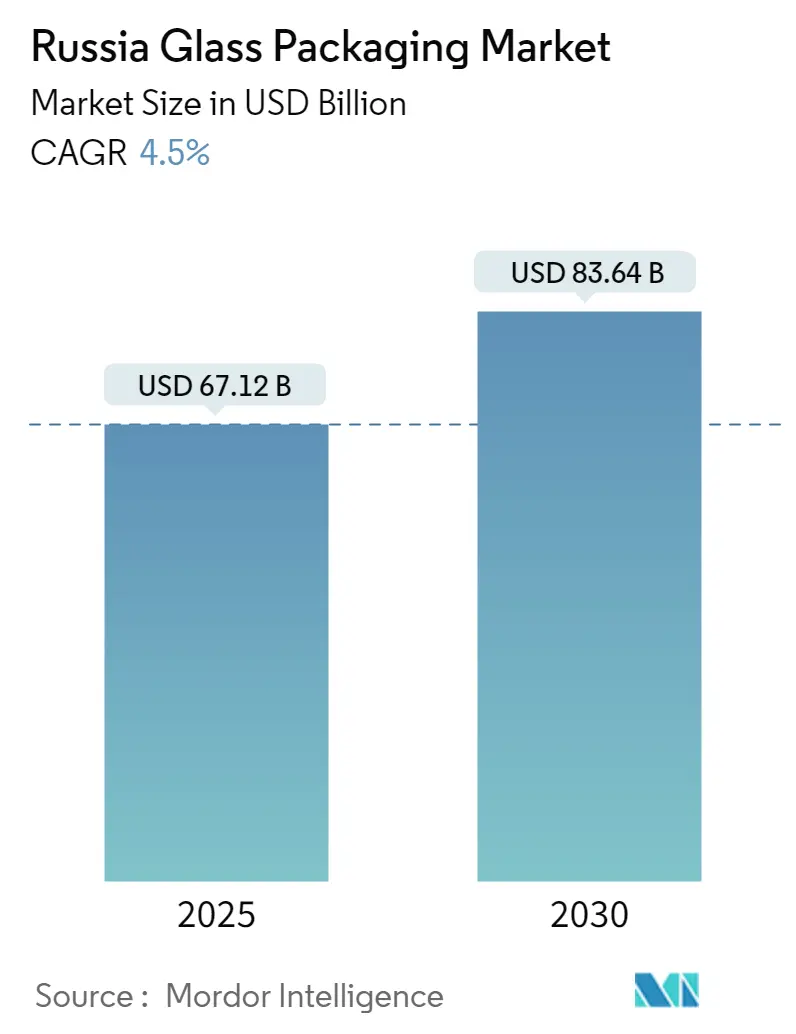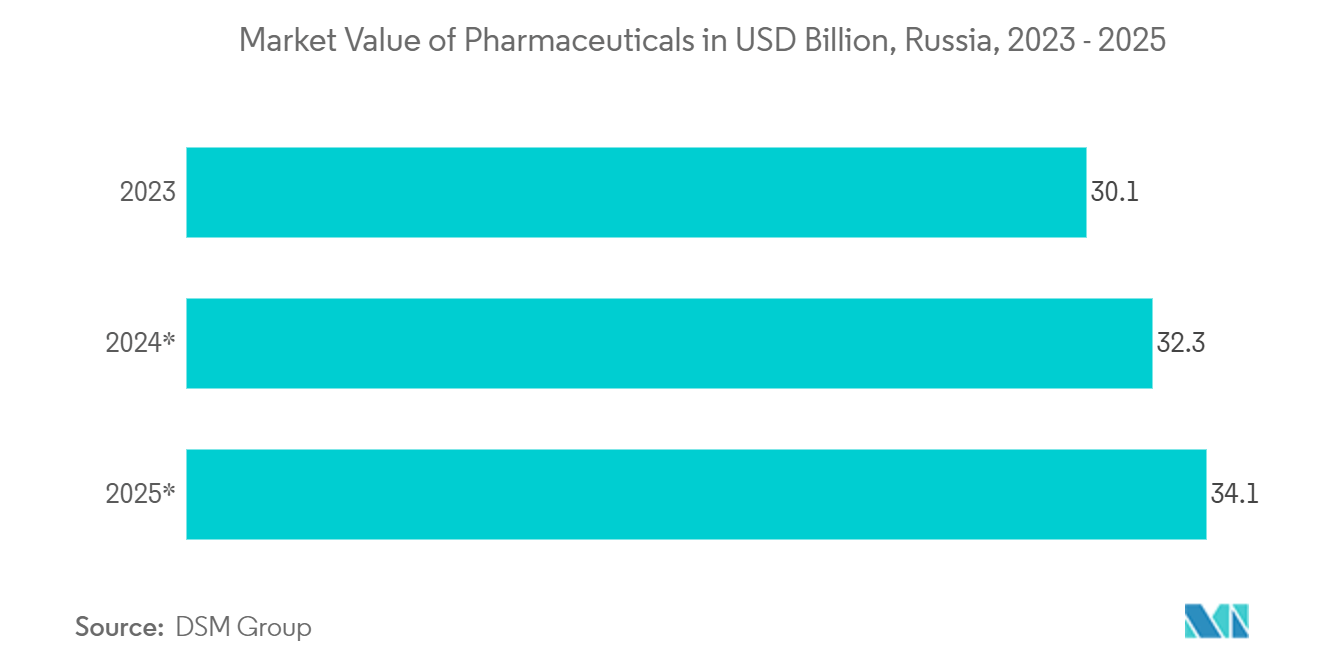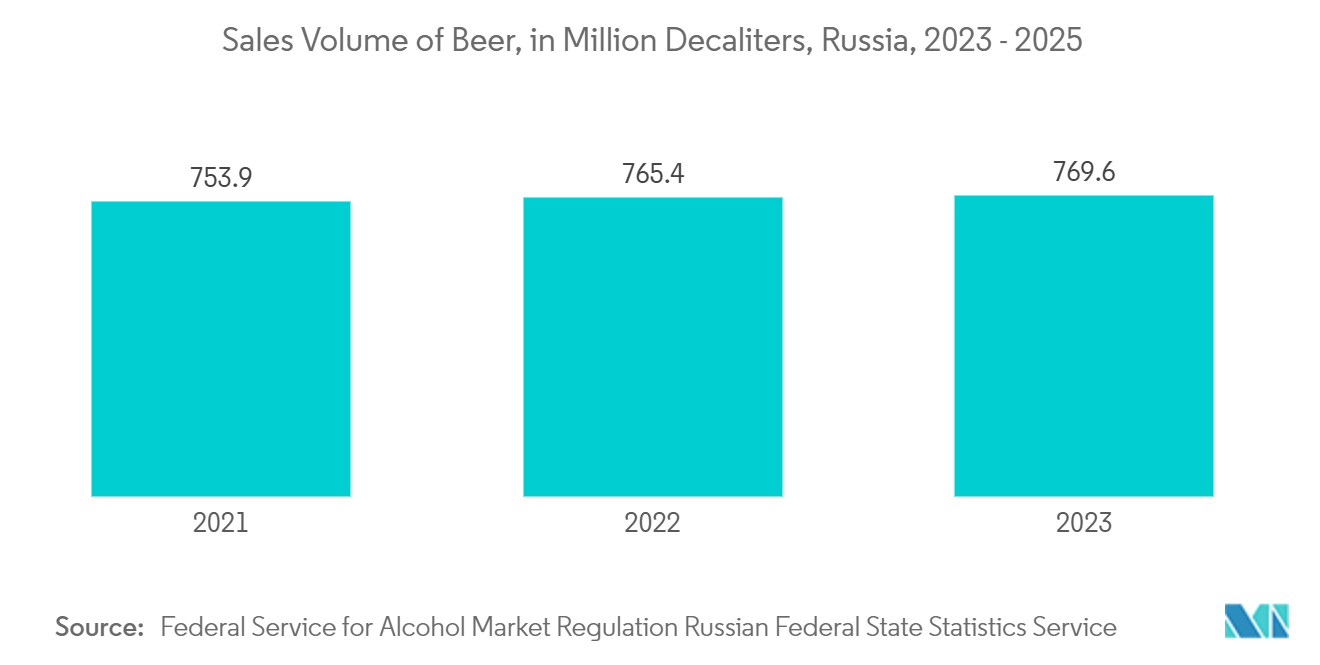
Russia Glass Packaging Market Analysis by Mordor Intelligence
The Russia Glass Packaging Market size is worth USD 67.12 Billion in 2025, growing at an 4.5% CAGR and is forecast to hit USD 83.64 Billion by 2030.
- The Glass Packaging Market in Russia represents a significant segment of the country's packaging industry, catering to various sectors such as food and beverage, pharmaceuticals, and cosmetics. This market is characterised by its durability, recyclability, and ability to preserve product quality, making it a preferred choice for many manufacturers. Russian glass packaging manufacturers face opportunities and challenges, including increasing demand for sustainable packaging solutions, technological advancements in production processes, and competition from alternative packaging materials. Increase production costs and.
- The Russian beverage industry is witnessing a growing preference for glass packaging. This trend is driven by several factors, including consumer perception of glass as a premium and environmentally friendly material. Glass bottles are increasingly used for alcoholic beverages, soft drinks, and mineral water in the Russian market. The recyclability and reusability of glass containers align with sustainability initiatives, further boosting their adoption. Additionally, glass packaging's ability to preserve product quality and extend shelf life makes it an attractive option for beverage manufacturers in Russia.
- The shift towards glass packaging is particularly noticeable in the premium beverage segment, where brands leverage the material's association with quality and luxury. Russian consumers often perceive products in glass containers as higher quality, which has led to increased demand for glass-packaged beverages. This trend is also influenced by the growing environmental awareness among Russian consumers, who are increasingly seeking sustainable packaging options.
- Further, growing consumer preference for safe and healthier packaging options is driving the expansion of glass packaging across various categories. Advanced technologies for embossing, shaping, and adding artistic finishes enhance the appeal of glass packaging among end users. Additionally, the increasing demand for eco-friendly products and the rising needs of the food and beverage market are contributing to the growth of the glass packaging market in Russia.
- Glass packaging dominates the exclusive pharmaceutical and personal care sectors in Russia. Its widespread use in these industries is due to its inert properties, which prevent chemical interactions with the contents, and its ability to maintain product integrity. The prevalence of glass in these sectors also reflects consumer preferences for premium packaging and the material's recyclability, aligning with sustainability trends in the Russian market.
- The Russian glass market is facing significant challenges due to the escalating international sanctions and growing isolation on the global stage. According to the Russian National Glass Union, these factors exert substantial pressure on the industry, impacting production, trade, and overall market dynamics. The tightening sanctions regime has led to disruptions in supply chains, limited access to international markets, and increased difficulties in obtaining necessary raw materials and technologies. As a result, the glass sector in Russia is experiencing a period of uncertainty and adaptation, with companies struggling to maintain operations and competitiveness in an increasingly constrained economic environment.
- Fluctuations in energy prices and supply chain bottlenecks may create significant challenges for glass packaging vendors. The glass manufacturing process is energy-intensive, making it particularly vulnerable to price volatility in the energy sector. These fluctuations can lead to increased production costs and potentially affect manufacturers' profit margins. Supply chain disruptions, exacerbated by global events and logistical challenges, have further complicated the situation for glass packaging producers. These bottlenecks can result in delays in raw material procurement, production schedules, and product delivery, impacting the overall efficiency of the glass packaging industry.
- The ongoing conflict between Russia and Ukraine has further constrained the market for glass packaging. This geopolitical situation has contributed to energy price instability and disrupted established supply chains, particularly in Europe. As a result, glass packaging vendors may need help maintaining consistent production levels and meeting market demands, potentially limiting growth opportunities in the sector.
Russia Glass Packaging Market Trends and Insights
Bottles and Containers to Hold Significant Market Share
- Glass bottles are extensively used in the pharmaceutical industry for packaging medicinal drugs. These bottles are manufactured to meet specific tolerance limits, as they are often filled on high-speed production lines. Glass is considered a viable packaging option due to its lower impact on human health and the environment than polyethene terephthalate (PET), making it an environmentally preferable packaging medium. The pharmaceutical industry values glass bottles for their inert properties, which help maintain drug stability and prevent chemical interactions between the container and its contents.
- Glass bottles offer excellent barrier properties against moisture and gases, preserving drug efficacy throughout their shelf life. The transparency of glass allows for easy visual inspection of the contents, which is crucial for quality control in pharmaceutical manufacturing and distribution processes. Furthermore, glass bottles can be easily sterilised and reused, contributing to sustainable packaging practices in the industry.
- The Russian pharmaceutical market reached USD 30.1 billion in 2023, a 0.2% increase from the previous year. Forecasts project the value of pharmaceutical sales to reach USD 34.1 billion by 2025. This growth in the pharmaceutical industry is driving demand for packaging solutions, particularly for communicable and non-communicable disease treatments. Consequently, there is an increasing need for glass packaging in pharmaceutical manufacturing. Glass packaging protects medicinal products against damage, bioaccumulation, and environmental factors.
- The rising demand for pharmaceutical drugs and medicines, coupled with technological advancements in the industry, directly contributes to the increased need for glass packaging solutions such as bottles and vials. As the Russian pharmaceutical market expands, the demand for high-quality glass packaging is expected to grow proportionally, ensuring the safe storage and distribution of various medications and treatments. This trend supports the pharmaceutical industry's growth and presents opportunities for glass packaging manufacturers to innovate and meet the market's evolving needs.
- Further, the primary factor driving the demand for glass bottles and containers in food packaging is the increasing need for food preservation. Glass provides an effective barrier against moisture, air, and other contaminants, helping to preserve the freshness, flavour, and nutritional value of food products for extended periods. Additionally, glass does not react with or leach chemicals into food, making it an ideal choice for packaging food products, particularly for sensitive items such as baby food.
- A diverse range of food products is packaged in glass containers, including instant coffee, processed baby foods, dry mixes, spices, dairy products, sugar preserves (jams and marmalades), syrups, spreads, processed fruits and vegetables, fish and meat products, mustards, and condiments. These products encompass various forms, from dry powders and granules to liquids, some of which are carbonated and packed under pressure, as well as heat-sterilized products.

Beverages Segment to Witness Significant Growth Rate
- The primary factor driving the demand for glass bottles and containers for beer in Russia is their ability to preserve taste and flavour. Glass packaging excels in maintaining product quality, making it the preferred choice for beer and cider manufacturers. Glass bottles, particularly in brown and green colours, provide essential UV protection for beer, safeguarding its taste and flavour from light and heat exposure. This protection is crucial for preserving the beer's quality during storage and transportation.
- Clear (flint) glass bottles are preferred for the alcoholic segment. They allow the product's colour and clarity to be showcased while still offering protection. Glass's inert nature ensures that it does not interact with the contents, further preserving the authentic taste of the beverages. These characteristics, combined with glass's recyclability and premium appearance, make glass bottles and containers the ideal packaging solution for alcoholic products in the Russian market, meeting the industry's functional and aesthetic requirements.
- Beer was the highest-selling alcoholic beverage in Russia, with sales exceeding 769 decaliters in 2023. This indicates a strong demand for beer and, consequently, for glass packaging used in beer bottles. The popularity of beer in Russia reflects consumer preferences and has implications for the packaging industry, particularly glass manufacturers. As beer is often sold in glass bottles, the high sales volume suggests a corresponding demand for glass packaging solutions. This trend may influence production strategies for glass manufacturers and impact the overall glass packaging market in Russia.
- Growing consumer interest in sustainability in Russia has led brewing companies to collaborate with glass bottle and container manufacturers. This partnership strategy aims to offer beer products in glass bottles, aligning with sustainability goals and meeting consumer preferences. These companies can develop eco-friendly packaging solutions, reduce waste, and improve recycling efforts by working together.
- The use of glass bottles not only addresses environmental concerns but also appeals to consumers who are increasingly conscious of the environmental impact of their purchasing decisions. This trend reflects a broader shift in the Russian beer market towards more sustainable practices and products, potentially influencing long-term industry strategies and consumer behaviour.
- Further, wine packaged in glass bottles offers a premium experience through design, elegance, and heritage. The unique aesthetics of glass bottles provide a luxury that other packaging materials cannot match. Wine is often used for gifting purposes on special occasions in developed countries.
- Consequently, wine packaged in distinctive glass bottles is advantageous over alternative packaging solutions. The combination of visual appeal, tactile quality, and cultural significance associated with glass bottles enhances the overall perception of the wine, making it a preferred choice for consumers seeking a refined and sophisticated product presentation.

Competitive Landscape
The Russian glass packaging market is fragmented, with several major players, such as Avangard-Glass, JSC, SCHOTT Pharma, and Krasnoye Echo LLC, holding significant market shares. These companies focus on expanding their customer base internationally and employing strategic collaborative initiatives to increase their market share and profitability.
Russia Glass Packaging Industry Leaders
-
Verallia Packaging
-
Sisecam
-
Avangard-Glass, JSC
-
SCHOTT Pharma
-
Krasnoye Echo LLC
- *Disclaimer: Major Players sorted in no particular order

Recent Industry Developments
- July 2024: Igor Sorokin, Deputy Governor of the Rostov Region, and Konstantin Nikulnikov, project manager of Alfa Pharm Glass LLC, have signed an agreement to establish production facilities for medical products made from borosilicate glass in the Rostov Region. The enterprise will produce import-substituting products from first hydrolytic class borosilicate glass, including glass tubes, ampules, and bottles. The annual production capacity is projected to be approximately 5,200 tons of finished products. This initiative aims to supply domestic enterprises with ampules, which are currently predominantly imported.
- March 2024: Chegem Glass Factory in the Kabardino-Balkarian Republic will introduce a second production line to boost medical glass production from 170 million to 300 million bottles annually by September 2024.
Russia Glass Packaging Market Report Scope
Glass remains a preferred packaging material for health-conscious and environmentally aware consumers. Manufactured from natural, sustainable raw materials such as sand, soda ash, and limestone, glass packaging effectively preserves the taste and flavor of products while maintaining the integrity and healthiness of food and beverages. The Russia Glass Packaging Market tracks the demand for several glass packaging options, including bottles and containers, ampoules, vials, syringes, jars, and other products across the end-user industries.
The Russia Glass Packaging Market is segmented by product type (bottles and containers, ampoules, vials, syringes, jars, and other product types) and end-user industry (beverage [liquor, beer, soft drinks, and other beverage types], food, cosmetics, pharmaceuticals, and other end-use industry types). The market sizes and forecasts are in terms of value in USD for all the above segments.
| Bottles and Containers |
| Ampoules |
| Vials |
| Syringes |
| Jars |
| Other Product Types |
| Beverage | Liquor |
| Beer | |
| Soft Drinks | |
| Other Beverages | |
| Food | |
| Cosmetics | |
| Pharmaceutical | |
| Other End-user Industries |
| By Product Type | Bottles and Containers | |
| Ampoules | ||
| Vials | ||
| Syringes | ||
| Jars | ||
| Other Product Types | ||
| By End-User Industry | Beverage | Liquor |
| Beer | ||
| Soft Drinks | ||
| Other Beverages | ||
| Food | ||
| Cosmetics | ||
| Pharmaceutical | ||
| Other End-user Industries | ||
Key Questions Answered in the Report
How big is the Russia Glass Packaging Market?
The Russia Glass Packaging Market size is worth USD 67.12 billion in 2025, growing at an 4.5% CAGR and is forecast to hit USD 83.64 billion by 2030.
What is the current Russia Glass Packaging Market size?
In 2025, the Russia Glass Packaging Market size is expected to reach USD 67.12 billion.
Who are the key players in Russia Glass Packaging Market?
Verallia Packaging, Sisecam, Avangard-Glass, JSC, SCHOTT Pharma and Krasnoye Echo LLC are the major companies operating in the Russia Glass Packaging Market.
What years does this Russia Glass Packaging Market cover, and what was the market size in 2024?
In 2024, the Russia Glass Packaging Market size was estimated at USD 64.10 billion. The report covers the Russia Glass Packaging Market historical market size for years: 2019, 2020, 2021, 2022, 2023 and 2024. The report also forecasts the Russia Glass Packaging Market size for years: 2025, 2026, 2027, 2028, 2029 and 2030.
Page last updated on:
Russia Glass Packaging Market Report
Statistics for the 2025 Russia Glass Packaging market share, size and revenue growth rate, created by Mordor Intelligence™ Industry Reports. Russia Glass Packaging analysis includes a market forecast outlook for 2025 to 2030 and historical overview. Get a sample of this industry analysis as a free report PDF download.
.webp)


